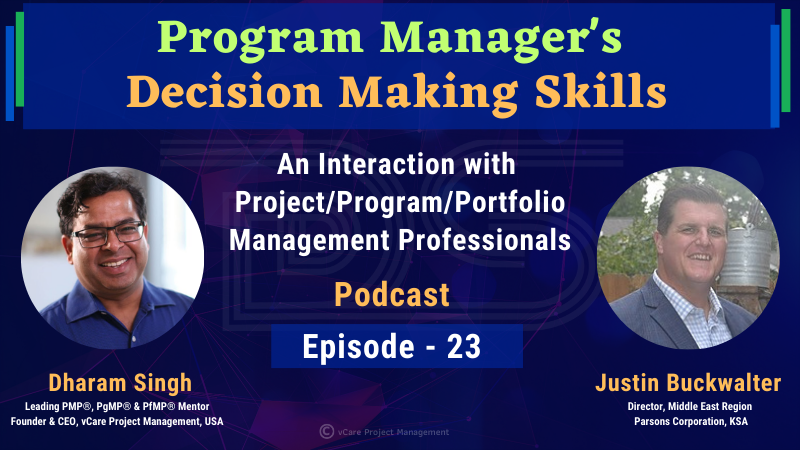
by DharamCW | Feb 12, 2025 | Leadership in Project Management, Podcast, Project-Program-Portfolio Management Knowledge
Program Managers Decision Making Skills | Justin Buckwalter | Program Management Insights Episode 23
🎥 Watch now: https://www.youtube.com/watch?v=MkmY_BJYEik
📚 Discussion Topics:
– Reflecting on Peter Drucker’s quote: “Whenever you see a successful business, someone once made a courageous decision.” How do you make courageous decisions in program management to navigate uncertainty and ensure project success?
– How do you address behavioural biases and analysis paralysis to ensure efficient and timely decision-making in your program management practice?
– Considering the World Economic Forum’s ‘Future of Jobs Report 2023’, which identifies critical thinking and decision-making as top skills for future professionals, how do you and your team strengthen these skills, and what decision-making frameworks or practices do you find most valuable in program management?
– How do you integrate feedback mechanisms across your program management practice to improve decision-making, and what broader lessons can you share from this process?
– Michael Porter often emphasized that “the essence of strategy is choosing what not to do.” How do you prioritize program objectives and decide what to exclude to ensure strategic alignment while balancing stakeholder expectations and resource constraints?
– What initiatives are companies taking to balance the integration of AI and machine learning with traditional decision-making processes in program management?
– How does ethical leadership influence success in contemporary projects, and what traits are organizations prioritizing in their leadership development programs?
– Regarding upskilling, what specific programs or training do you see as most beneficial for program managers to enhance their decision-making capabilities in the face of rapid technological change?
– How are current trends and challenges in program management influencing the strategic priorities of organizations, and what steps are being taken to equip managers with the skills needed for future challenges?
🚀 Looking to deepen your knowledge? Check out our upcoming webinars featuring global experts,
1. Culture, People, Programs, Risks: Leadership Redefined featuring Lucie Ellis – https://bit.ly/3VXv4mW
2. Turning Business Goals into Reality featuring Marcelo Pessotto – https://bit.ly/4hhH4Yu
3. Resilient Leadership in Cyber-Driven Programs: Strategies from a Transformation Expert featuring Dr. Maria Sette – https://bit.ly/4j9fmPA
– Book an obligation-free consultation session on Project management Career, training, and certifications: http://talktodharam.com
#ProgramManagement #DecisionMaking #LeadershipDevelopment #PgMP #PfMP #PMP #StrategicLeadership #ProjectSuccess #CriticalThinking #ProgramManager #StakeholderEngagement #AIIntegration #EthicalLeadership #FutureOfWork #RiskManagement #AskDharam #VCareProjectManagement

by DharamCW | Jan 24, 2025 | Program Management, Project Management
Driving Business Viability Through Benefits Management | Tom Witterholt | Dharam | PMI PgMP | Episode 8
How can a Program Manager improve business viability through effective benefits management inside and outside the company?
– Delivering Value – Benefits Management
– Internal Program Benefits vs. External Program Benefits
Video Link: https://www.youtube.com/watch?v=WLqRW70gmfI
🚀 Looking to deepen your knowledge? Check out our upcoming webinars featuring global experts,
1. PMO Digital Transformation Leadership: Insights and Success featuring Sherwyn Cambridge – https://bit.ly/4iMvyWE
2. Culture, People, Programs, Risks: Leadership Redefined featuring Lucie Ellis – https://bit.ly/3VXv4mW
3. Resilient Leadership in Cyber-Driven Programs: Strategies from a Transformation Expert featuring Dr. Maria Sette – https://bit.ly/4j9fmPA
– Book an obligation-free consultation session on Project management Career, training, and certifications: http://talktodharam.com
– Discover training offers and certification discounts: https://bit.ly/3jWVepD
– Stay updated with our Q&A series and certification success stories by subscribing to the vCare Project Management YouTube channel at https://bit.ly/2YF0wJl
– Follow my podcasts and interviews with Project Management Experts on YouTube at https://bit.ly/2NDY8wd
#ProgramManagement #BenefitsManagement #PMI #PgMP #BusinessViability #DeliveringValue #BusinessSuccess #StrategicManagement #ValueCreation #InternalBenefits #ExternalBenefits #ProjectManagement #BusinessTransformation #CorporateStrategy #ProgramSuccess #ProgramManager #AskDharam #DharamSingh #DharamSinghPgMP #DharamSinghPfMP #TomWitterholt #DharamSinghPMP #vCareProjectManagement
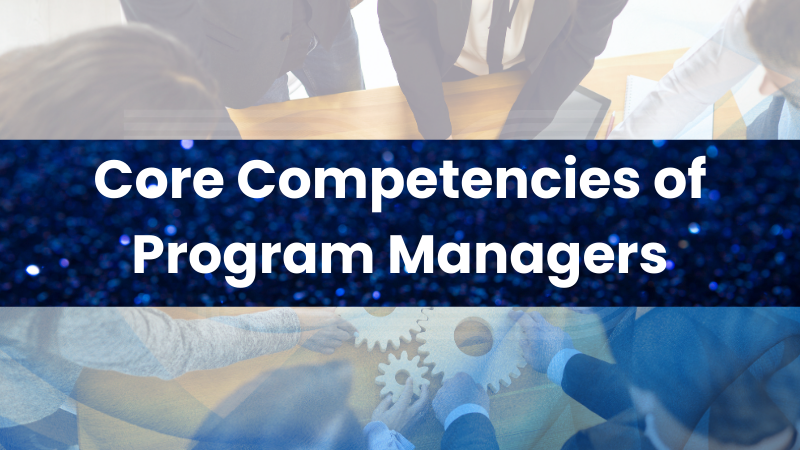
by DharamCW | Jan 22, 2025 | Program Management
Top 10 Core Competencies of Program Managers | Skills for Success | Dharam Singh & vCare Project Management
There are many similarities between a good program manager and a good project manager. However, a program manager must have broader organizational knowledge than a project manager. In addition, programs frequently necessitate strategic visioning and planning skills to align overall program goals and benefits with the organization’s long-term goals.
Here are the top ten core competencies of Program Managers:
1. Leadership and Teamwork
2. Planning and Organizing
3. Communication
4. Ethics and Ethical Values:
5. Internal and External Stakeholder Engagement
6. Political Understanding
7. Knowledge management
8. Financial Management
9. Risk management
10. Project and Process Management
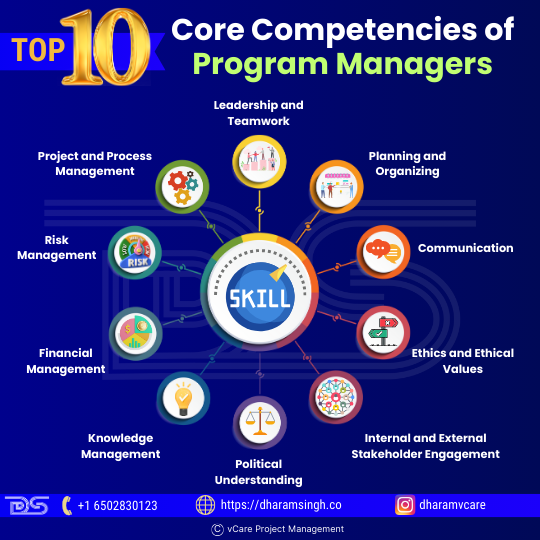
What makes a great program manager? Explore the top 10 core competencies essential for program success with insights from Dharam Singh & vCare Project Management!
🚀 Looking to deepen your knowledge? Check out our upcoming webinars featuring global experts,
1. Innovative Project Management Practices featuring Olajumoke Akinwunmi – https://bit.ly/3ZxZOx4
2. PMO Digital Transformation Leadership: Insights and Success featuring Sherwyn Cambridge – https://bit.ly/4iMvyWE
3. Culture, People, Programs, Risks: Leadership Redefined featuring Lucie Ellis – https://bit.ly/3VXv4mW
4. Resilient Leadership in Cyber-Driven Programs: Strategies from a Transformation Expert featuring Dr. Maria Sette – https://bit.ly/4j9fmPA
– Book an obligation-free consultation session on Project management Career, training, and certifications: http://talktodharam.com
– Discover training offers and certification discounts: https://bit.ly/3jWVepD
– Stay updated with our Q&A series and certification success stories by subscribing to the vCare Project Management YouTube channel at https://bit.ly/2YF0wJl
– Follow my podcasts and interviews with Project Management Experts on YouTube at https://bit.ly/2NDY8wd
#ProgramManagement #ProgramManager #ProjectManager #ProjectManagement #StrategicPlanning #StakeholderEngagement #CommunicationSkills #EthicsInLeadership #RiskManagement #FinancialManagement #Leadership #Teamwork #KnowledgeManagement #OrganizationalGrowth #ProgramLeadership #PgMP #PfMP #PMP #ProcessManagement #BusinessStrategy #ProgramSuccess #PoliticalAwareness #ManagerialSkills #AskDharam #DharamSingh #DharamSinghPgMP #DharamSinghPfMP #DharamSinghPMP #vCareProjectManagement

by DharamCW | Oct 18, 2024 | Uncategorized
🎉 Celebrating Excellence in Program & Portfolio Management! 🎉
It’s time to celebrate the incredible achievements of a dedicated group of professionals. Congratulations to each of you who obtained your PgMP® and PfMP® certifications with the guidance and support of vCare Project Management from July to September 2024! 🚀
Many professionals will now find inspiration in your success, highlighting the effectiveness of vCare Project Management’s training and mentoring programs.
Thank you for embarking on this journey with us.
vCare’s Global Reach:
🎓 Supported 515 PgMP®s across 55 countries
🎓 Supported 145 PfMP®s across 30 countries
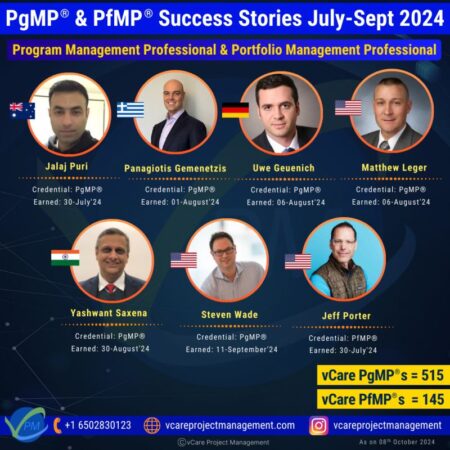
Join us in celebrating the success of PgMP & PfMP achievers with vCare Project Management. Start your journey today!
🌟 To Aspiring Certification Candidates Worldwide:
If you’re a Project, Program, or Portfolio Management Professional looking to boost your career, let this success story inspire you. Although the journey towards certification can be challenging, it is worth embarking on with the right guidance and support. At vCare Project Management, we are dedicated to being a part of your success story by providing you with the necessary expertise and support to help you achieve your goals.
🔍 Looking Ahead:
Accompany more professionals on their learning journey and support their growth and achievements in the upcoming years. Here’s to a year of success stories!
🚀 Elevate Your Project Management Career:
– Register for my upcoming PMI Certification Success Story Webinars:
1. Proven Portfolio Management Strategies featuring Scott McLeod – https://bit.ly/3Mx38kN
2. Dual PfMP & PgMP Success: Strategic Insights with Peter Kazimir – https://bit.ly/3ztTywc
3. From PMP to PgMP: Project to Program Management Transition featuring Moayad Alkhatib – https://bit.ly/4gLja8o
– Book an obligation-free consultation session on Project management Career, training, and certifications: http://talktodharam.com
– Discover training offers and certification discounts: https://bit.ly/3jWVepD
– Stay updated with our Q&A series and certification success stories by subscribing to the vCare Project Management YouTube channel at https://bit.ly/2YF0wJl
– Follow my podcasts and interviews with Project Management Experts on YouTube at https://bit.ly/2NDY8wd
#PgMP #PfMP #vCareProjectManagement #PfMPExamPrep2024 #PgMPExamPrep2024 #vCareSuccess #CertificationJourney #PMI #PfMPSuccess #PgMPSuccess #PgMPCourse #PgMPTraining #PgMPPreparation #PfMPCertification #PfMPCourse #PgMPCertification #PfMPExam #PfMPTraining #ProjectManagement #PortfolioManagement #ProgramManager #ProjectManager #ProgramManagement #PMICertification #PortfolioManager #ProjectLeaders #CareerGrowth #GlobalProfessionals #SuccessStory #GlobalPMCommunity #ProjectLeadership #PMITraining #InspiringSuccess #AskDharam #DharamSingh #DharamSinghPgMP #DharamSinghPfMP
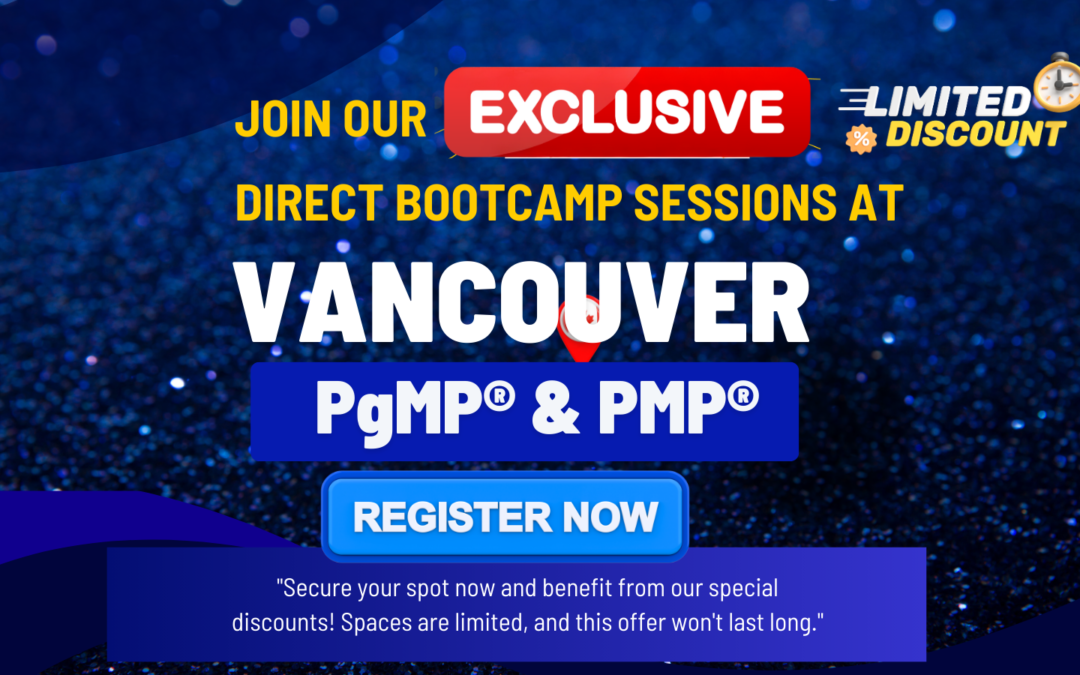
by DharamCW | Sep 16, 2024 | vCare PMI Certification Training Classes
Hello Vancouver professionals! 🌟
Exciting news! I’ll be in Vancouver this October 2024 to lead specialized PgMP and PMP boot camps. 🚀 These intensive training programs will equip you with the knowledge and skills to succeed in program and project management.
Here’s why you don’t want to miss out:
1. Master the required skills to excel in PgMP and PMP exams.
2. Learn from the best who has guided 510+ global PgMP professionals and thousands of PMP professionals across 55 countries.
3. Enhance your resume with coveted PgMP and PMP certifications.
4. Network with like-minded professionals in the project and program management field.
Plus, register early and save! ⏰
1. PgMP Boot camp, Vancouver, Canada – https://bit.ly/4cQAuWi
Date: 5 -7 October 2024
Course Fee: $1999
Early Bird Special: Only $1599 (Register before September 15th and save $400)
2. PMP Boot camp, Vancouver, Canada – https://bit.ly/47bz47Q
Date: 8 – 11 October 2024
Course Fee: $1799
Early Bird Special: Only $1299 (Register before September 15th and save $500)
Register today and take the first step towards a rewarding project and program management career.
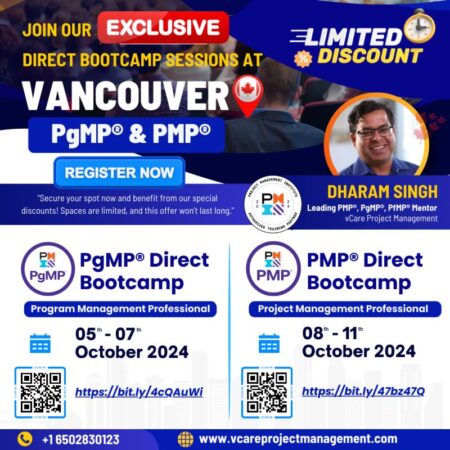
Join the PgMP & PMP boot camps in Vancouver this October 2024 and elevate your project management career. Register now!
For more insights into project and program management certifications, training, and career development, book a personalized, obligation-free consultation session with me by visiting talktodharam.com
Take advantage of this opportunity to elevate your career! 🌟
#PgMP #PMP #ProjectManagement #ProgramManagement #Vancouver #vCareProjectManagement #Canada #PMIATP #PMPTraining #PgMPExam #PgMPBootcamp #PMPBootcamp #PgMPCourse #PgMPCertification #PgMPTraining #PMPPgMP #PgMPPreparation #PgMPGuide #PgMPPrep #PMPCertification #PMPExam #PMPCourse #PMPClass #PMPPrep #PMPStudy #AskDharam #DharamSingh #ProgramManager #ProjectManager #PMICertification #DharamSinghPgMP #DharamSinghPfMP #DharamSinghPMP











Recent Comments